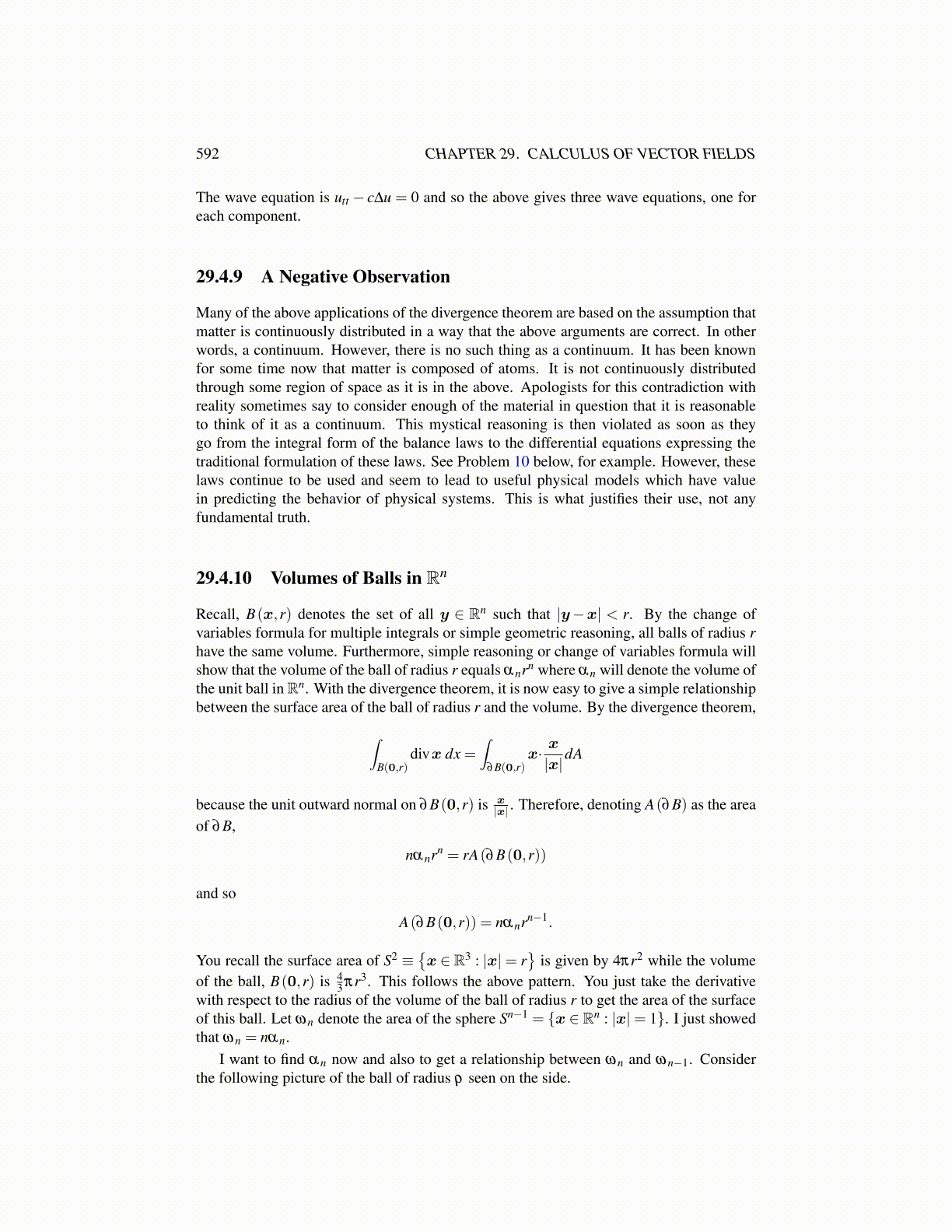
592 CHAPTER 29. CALCULUS OF VECTOR FIELDS
Ji = −∑ j Ki j∂c∂x j
. Here c is the concentration which means the amount of pollutantor whatever is diffusing in a volume is obtained by integrating c over the volume.Derive a formula for a nonhomogeneous model of diffusion based on the above.
4. Let V be such that the divergence theorem holds. Show that∫
V ∇ · (u∇v) dV =∫∂V u ∂v
∂n dA where n is the exterior normal and ∂v∂n denotes the directional derivative
of v in the direction n.
5. Let V be such that the divergence theorem holds. Show that∫V
(v∇
2u−u∇2v)
dV =∫
∂V
(v
∂u∂n
−u∂v∂n
)dA
where n is the exterior normal and ∂u∂n is defined in Problem 4.
6. Let V be a ball and suppose ∇2u = f in V while u = g on ∂V . Show that there
is at most one solution to this boundary value problem which is C2 in V and con-tinuous on V with its boundary. Hint: You might consider w = u− v where u andv are solutions to the problem. Then use the result of Problem 4 and the identityw∇
2w = ∇ · (w∇w)−∇w ·∇w to conclude ∇w = 0. Then show this implies w mustbe a constant by considering h(t) = w(t x+ (1− t)y) and showing h is a constant.Alternatively, you might consider the maximum principle.
7. Show that∫
∂V ∇×v ·ndA = 0 where V is a region for which the divergence theoremholds and v is a C2 vector field.
8. Let F (x,y,z) = (x,y,z) be a vector field in R3 and let V be a three dimensional shapeand let n= (n1,n2,n3). Show that
∫∂V (xn1 + yn2 + zn3) dA = 3× volume of V .
9. Let F = xi+yj+zk and let V denote the tetrahedron formed by the planes, x= 0,y=0,z = 0, and 1
3 x+ 13 y+ 1
5 z = 1. Verify the divergence theorem for this example.
10. Suppose f : U →R is continuous where U is some open set and for all B ⊆U whereB is a ball,
∫B f (x) dV = 0. Show that this implies f (x) = 0 for all x ∈U .
11. Let U denote the box centered at (0,0,0) with sides parallel to the coordinate planeswhich has width 4, length 2 and height 3. Find the flux integral
∫∂U F ·ndS where
F = (x+3,2y,3z). Hint: If you like, you might want to use the divergence theorem.
12. Find the flux out of the cylinder whose base is x2 + y2 ≤ 1 which has height 2 of thevector field F =
(xy,zy,z2 + x
).
13. Find the flux out of the ball of radius 4 centered at 0 of the vector field F =(x,zy,z+ x).
14. Verify 29.16 from 29.13 and the assumption that S = kF .
15. Show that if uk,k = 1,2, · · · ,n each satisfies 29.7 with f = 0 then for any choice ofconstants c1, · · · ,cn, so does ∑
nk=1 ckuk.